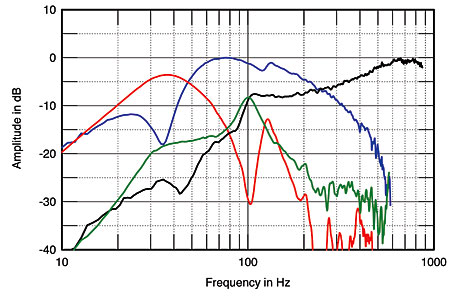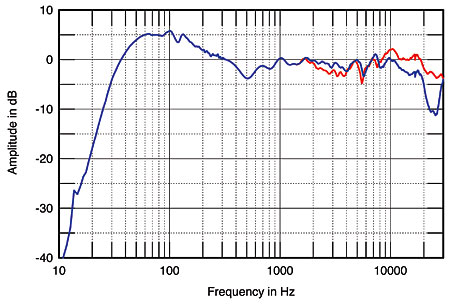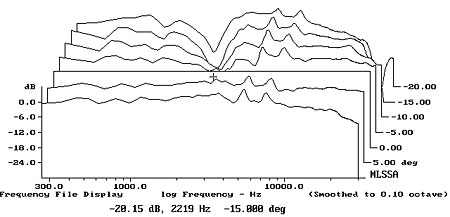| Columns Retired Columns & Blogs |
Sonus Faber Cremona Elipsa loudspeaker Measurements
Sidebar 3: Measurements
The Cremona Elipsa has a usefully higher voltage sensitivity than average, at an estimated 90dB(B)/2.83V/m. Though this is slightly lower than the specified 91dB, the shortfall is not important. While it will therefore require less of a voltage swing to play loud, the speaker is still a demanding load for the partnering amplifier, with an impedance magnitude that drops to 2.5 ohms throughout the upper bass (fig.1). There is also a punishing combination of 4 ohms magnitude and –50 ° electrical phase angle at 70Hz that will suck gobs of current from the amplifier.

Fig.1 Sonus Faber Cremona Elipsa, electrical impedance (solid) and phase (dashed). (2 ohms/vertical div.)
There is a suspicious-looking wrinkle in the impedance traces around 125Hz. Investigating the vibrational behavior of the cabinet panels with an accelerometer, I did find a resonant mode in that region on the front and rear panels, along with others at 154 and 387Hz (fig.2). These may well be associated with the slight warmth I noted in my auditioning.

Fig.2 Sonus Faber Cremona Elipsa, cumulative spectral-decay plot calculated from the output of an accelerometer fastened to the center of the front baffle to the side of the midrange unit (MLS driving voltage to speaker, 7.55V; measurement bandwidth, 2kHz).
The shape of the impedance-magnitude trace in the bass suggests that the lower two of the three ports on the speaker's rear, which load the woofer, are tuned to a frequency of 32Hz. The top port loads the midrange unit, and, as with other Sonus Faber speakers, the Elipsa's low-frequency behavior is complex. Fig.3 shows the individual behaviors of the midrange unit (black trace), the woofer (blue), the topmost port (green), and the sum of the bottom two ports (red), all measured in the nearfield —ie, with a small-diameter microphone very close to the diaphragms —and scaled in the ratio of the square root of the radiating areas.

Fig.3 Sonus Faber Cremona Elipsa, nearfield responses of midrange unit (black), upper port (green), woofer (blue), and lower ports (red), all plotted in the ratios of their radiating diameters.
The crossover from the woofer to the midrange unit is set at around 250Hz, with initially shallow filter slopes. The woofer's output features the usual minimum-motion notch at the port tuning frequency, while the sum of the lower-port outputs broadly peaks in the same region: classic reflex behavior. However, there is a discontinuity at 125Hz in the woofer output and a peak in the ports' output at the same frequency, this also where the wrinkle is apparent in the impedance graph. Some sort of acoustic resonance is present at this frequency, which might also have contributed to the feeling of upper-bass warmth I commented on in my "Sonus Sonics" section. The notch in the midrange unit's low-frequency response indicates that its port is tuned to a low 43Hz; though that port does have a very slight peak at that frequency, the main peak in its output occurs an octave-and-a-half higher in frequency, where the midrange unit has its rolloff "corner" and the woofer ports have a deep notch. The reflex tuning of the midrange unit and its port is presumably affected by the series impedance of the high-pass crossover filter.
Predicting how these four individual low-frequency outputs will add in the farfield is not trivial. The blue trace to the left of fig.4 shows the complex sum of the nearfield responses, taking into account both acoustic phase and the different distances of each radiator to a nominal listening position. The broad, smooth hump in output in the mid- and upper bass will be due in part to the nearfield measurement technique, but it does suggest that the Elipsa has a little too much bass energy to sound truly neutral in all but very large rooms. The resonant problem in the upper bass results only in a mild perturbation of the calculated response. The speaker's output rolls off sharply below 30Hz.

Fig.4 Sonus Faber Cremona Elipsa, anechoic response without grille on tweeter axis (red) and midrange axis (blue) at 50", averaged across 30° horizontal window and corrected for microphone response, with the complex sum of the nearfield responses plotted below 300Hz.
Higher in frequency, the Elipsa's farfield response is impressively flat, though the details of that flatness do depend quite critically on exact listening axis, which is why experimenting with the baffle's rake angle produces relatively large changes in perceived treble balance. The red trace in fig.4 shows the response on the tweeter axis, 36" from the floor, the blue that on the midrange axis, 32" from the floor. It should be apparent that for a seated listener whose ears are 36" from the floor (the average found by UltimateAVmag.com's Tom Norton back in the early 1990s, when he was Stereophile's Technical Editor), tilting the speaker back will reduce the top-octave level but increase the presence region a little.
All the measurements so far were taken with the grille removed. However, as with other Sonus Faber speakers I have measured, the vertical-string grille has only a mild effect on the farfield frequency response, with some mild comb-filtering apparent (fig.5).

Fig.5 Sonus Faber Cremona Elipsa, difference made by grille in tweeter-axis response (5dB/vertical div.).
The Elipsa's lateral radiation pattern is superbly wide and even in the mid-treble and below, but features a sharp discontinuity at 7.5kHz (fig.6). Above that frequency, the wide baffle drastically restricts the tweeter's off-axis output. As a result, the speaker might sound a little airless in large rooms. In the vertical plane (fig.7), a large suckout develops at 2.3kHz, the upper crossover frequency, for listener ear heights above the tweeter axis. As discussed above, the asymmetric spikes should be used to place the listener's ears somewhere between the tweeter and midrange axes, though exactly where will depend on the room acoustic and the tonal character of the listener's system.

Fig.6 Sonus Faber Cremona Elipsa, lateral response family at 50", normalized to response on tweeter axis, from back to front: differences in response 90 –5 ° off axis, reference response, differences in response 5 –90 ° off axis.

Fig.7 Sonus Faber Cremona Elipsa, vertical response family at 50", normalized to response on tweeter axis, from back to front: differences in response 20 –5 ° above axis, reference response, differences in response 5 –10 ° below axis.
Fig.8 shows how all this quasi-anechoic measured behavior summed in my listening room. I took four 1/6-octave –smoothed responses for each speaker individually at 10 microphone positions in a grid centered on the position of my ears in my listening chair, using an Earthworks omnidirectional microphone and SMUG Software's Fuzzmeasure program running on my Apple laptop. This technique integrates the direct output of the speakers with the reverberant field in the room, and to a large extent smooths out the effect of low-frequency room resonances. The peaks at 30 and 150Hz and the dip at 45Hz are residual room effects; the suckout in the middle of the midrange is due to the Allison Effect, in which the direct sound of the midrange unit is interfered with by the reflection of its output from the room boundaries. But note how smooth and flat the Elipsa's upper-frequency output is in-room. Yes, there is a very slight energy excess apparent in the tweeter's bottom octave that correlates with the slight brightness I noted, but the speaker's upper midrange and treble measure as neutral as I would have expected from my auditioning.

Fig.8 Sonus Faber Cremona Elipsa, spatially averaged, 1/6-octave response in JA's listening room.
In the time domain, the Cremona Elipsa's step response, measured on the tweeter axis (fig.9), indicates that the tweeter and woofer are connected in positive acoustic polarity and the midrange unit in negative, which is what you need with second-order crossover filters to get good frequency-domain integration between their outputs on the intended listening axis. Note how each unit's step smoothly hands over to that of the next lower in frequency —exactly what is needed. The Elipsa's cumulative spectral-decay plot (fig.10) is very clean in the treble, but a little less so in the midrange, where some low-level modes are apparent.

Fig.9 Sonus Faber Cremona Elipsa, step response on tweeter axis at 50" (5ms time window, 30kHz bandwidth).

Fig.10 Sonus Faber Cremona Elipsa, cumulative spectral-decay plot at 50" (0.15ms risetime).
Overall, I was impressed by the Sonus Faber Cremona Elipsa's measured performance. It demonstrates some excellent loudspeaker engineering, although, as with some other expensive loudspeakers, I do wonder if a simpler low-frequency arrangement might produce more consistent results. But this is a minor quibble, considering how fine the speaker sounds. —John Atkinson
- Log in or register to post comments




































